| Reloading labor saving tips by Cliff Hanger #3720LR
Last month on the SASS wire there was a thread about reloading
and what is your most hated part of the process? After following this thread,
I thought I would tell you what I do to make it a little easier.
1. Separating media from brass. I have used many
things to do this. I started out by doing it by hand. Taking each and every
piece of brass and turning it so the opening was down and tapping it on
the bench top. It didn't take long to figure this was not going to be very
productive as far as trying to reload hundreds of rounds every week to
keep up with shooting a match or two every weekend. So I took an old aluminum
colander and drill the holes bigger. 1/4" Well this was better but by no
means efficient. Next I invested in one of those advertises media separators
baskets that go over a 5 gallon bucket. Better than the colander but not
much. Then looking at other separators I decided to build my own.
I started with two 12" diameter 5/8" plywood circles from
Home Depot. I drilled a 1/2" hole in the center of both. I then cut them
sort of in half. Off center by 1.5". I made an axle of 1/2" steel rod.
Welded a handle to it and a small 3" plate on the axle. The axle was inserted
through the plywood circles. I use 3/8" hardware cloth to go around the
wood circles to make a large basket. I used aluminum strips, 1/2" by 1/8"
to support the wire. I bought a big plastic tub and installed two bolts
at each end to keep the axle in place while turning. Actually I bought
the tub and made the basket to fit inside. Two latches to hold the two
halves together.
Media, small rocks and primers fall right though the hardware
cloth. A few turns of the basket and your done. BUT there is the occasional
media pieces in the case feeder on my Dillons. I fixed that by drilling
the two small holes on the bottom of the case feeder just large enough
for a large pistol primer to fall through. Then you can tape a small plastic
bag under the case feeder to catch all the media and other stuff that falls
through.
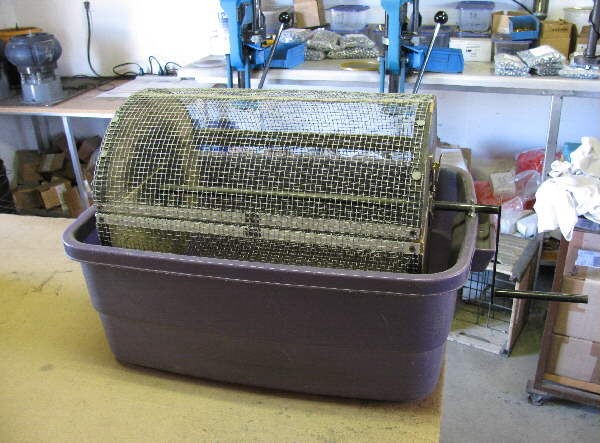
This is my media separator.
. |
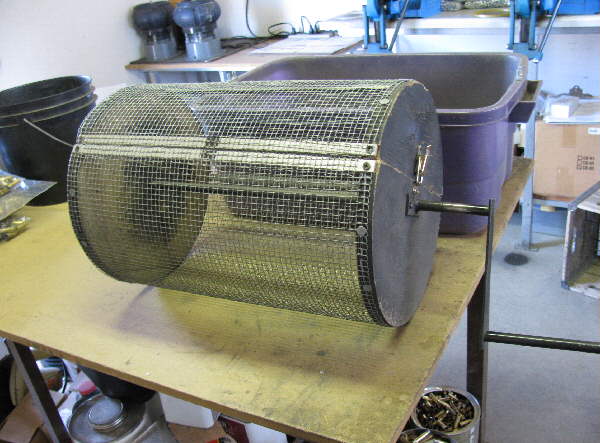
The complete basket
. |
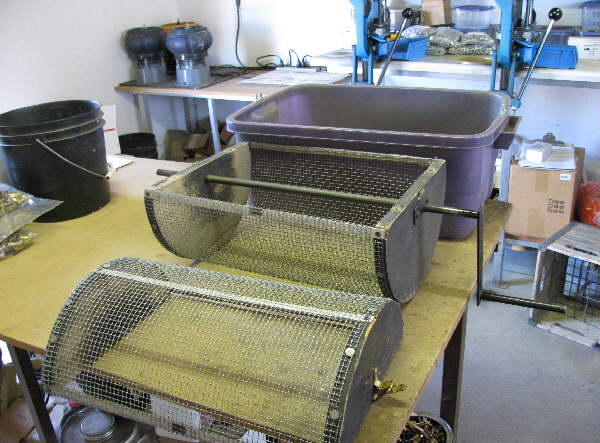
The basket opened up
. |
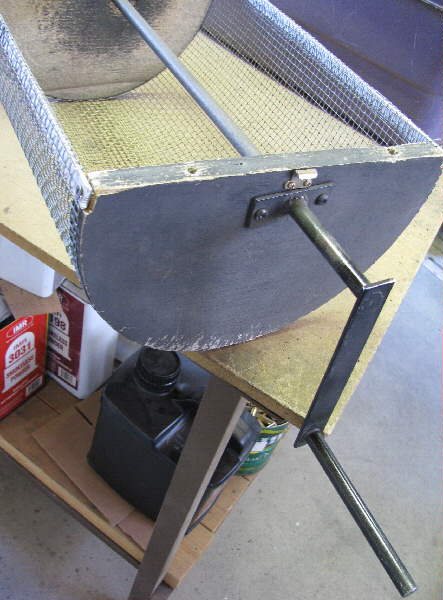
Looking at the end of the basket where the handle is
attached by two 1/4" bolts.
. |
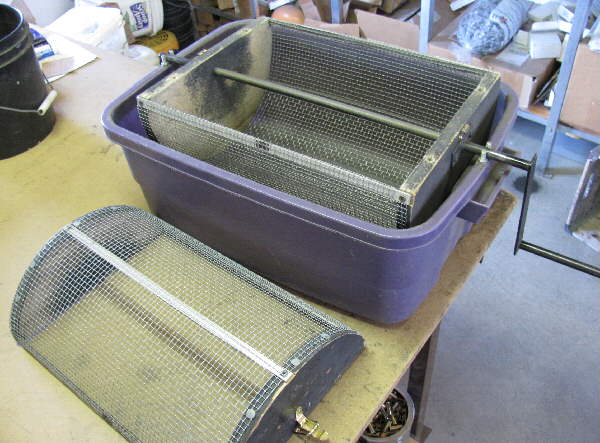
Basket read for media and brass |

Dumping 500 38spl from the tumbler
in to the separator |
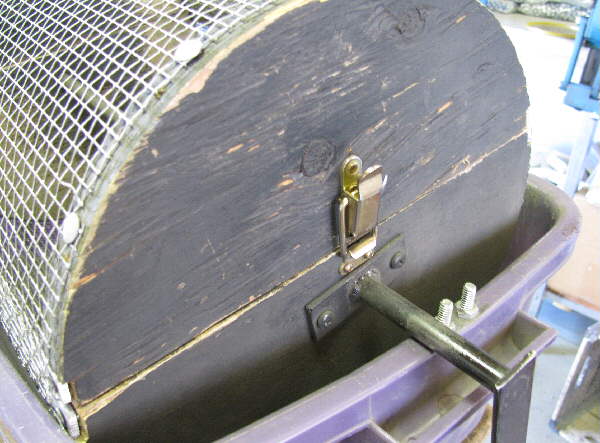
Showing the latch holding the two halves together and
the two bolts in the tub that the axle rides between |
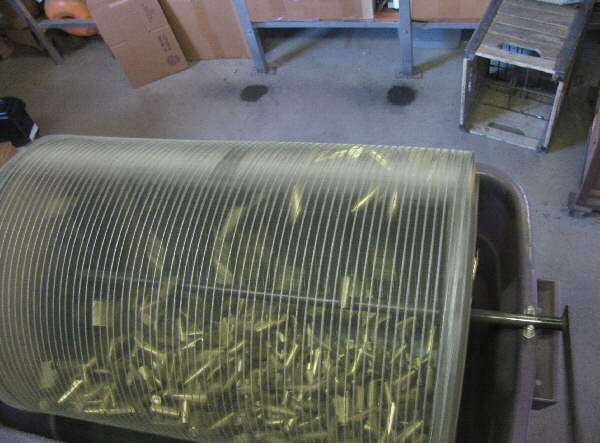
Spinning the basket slowly.
About 10 turns will separate the media from the brass |
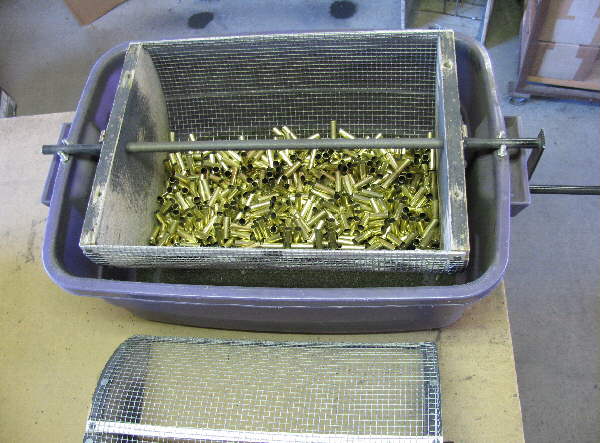
Clean brass ready for the press.
. |
2. Cleaning the lube out of the dies. This one
is very simple. Clean the lube out when it's cold. The wax is brittle and
will flake out easily. If it's summer, put the tool head in the refrigerator
over night. I pull the seating plug out and I use a small screw driver
blade. I do this first thing every morning when I go in to the shop. I
have dummy rounds made up in several calibers and various lengths. I use
them to reset the dies for the job at hand. I hear some complain about
having to adjust dies. Me, I adjust dies several times a day to fit the
job at hand. Not a problem and takes only a few seconds once I find the
right dummy round.
In the winter the lube builds up and the bullets tend
to seat deeper and deeper as you do more rounds. In the summer the lube
builds up and is soft. It gets all over the bullet nose making a mess of
things.
3. Lubing cases before sizing. I lube all
rifle caliber cases and all bottle neck cases before resizing. So here
is my process.
I have a tool head that has nothing in it. When I need
to resize brass I find the appropriate sizing die. I remove the decapping
pin and put the die in station #3. (650 Dillon) That's right....Station
#3. My reason is I do not want to punch the primer out at this
time. By doing this I don't have to have the sizing die in station #1.
Station #3 is the easiest one to get to. I can make sure the case is straight
as it goes in to the sizing die with a light touch. This reduces crushed
cases during sizing by almost 100%.
I use One Shot spray lube. I toss a hand full of brass
in a small bucket. Spray it lightly. I move the brass around in the bucket
and lightly spray again. This should cover almost all the case surface.
Now I run all the brass through the press. Once completed I have sized
but still lubed brass. I toss the brass back in to the tumblers for about
10 or 15 minutes. This removes the lube. Now back to the press.
I change out the tool head with the tool head that has
all the dies in it and powder measure. There is one exception. Station
#1 does not get a sizing die. It gets a Universal Decapping die. This die
has a very large opening. It will take 45-70 cases without touching the
case walls. The only thing this dies does is remove the primers. Remember
I left the primers in up to now. The brass has been in the tumbler twice
so far. Media tends to get stuck in the primer holes if the primer is out.
Media also gets stuck in the primer itself. So by leaving the primer in
until I am actually loading the case, the media that may be in the primer
hole or primer back will be pressed out.
After reloading the brass I shouldn't have to wipe the
rounds down to get the lube off. I did that in the tumbler between resizing
and reloading.
4. Making Dummy Rounds. If you reload several calibers
or rounds of the same caliber but different length this will help save
you time. When you clean the lube out of your bullet seating die you can
use a dummy round to get your adjustments back to within .001". Or if you
change overall length like going from a 38spl of say 1.46" to a long 38spl
of 1.54" to feed better in a lever rifle, you just back the seating plug
out a bit and run the appropriate dummy round up in to the die. Screw down
the adjustment plug hand tight and you're close. So I have Dummy rounds
in most cas calibers, several bullet shapes, bullet weights and various
lengths of each. Depends on the customer's requirements. I have my customers
try different lengths, weights and shapes until they find what works best
in their rifles at the speed they work the action. I mark this information
in my book so I can duplicate it when their brass comes in again. The pistols
don't seem to care much. They shoot what ever fits.
I have one customer that has several rifles in the same
caliber but they don't like sharing the same length rounds. I think I have
3 lengths for 5 rifles. The customer has to tell me which rifle the rounds
will be used in. Yes, we numbered each rifle to make this easier.
Last three number of serial number.
If you have any little tricks to make reloading easier
or the Dillon press work better, I would like to hear about it. I would
be happy to put that information here in the Brimstone gazette.
CH
|
4 bore from Wikipedia
| Four bore or 4 bore is an obsolete black powder caliber
of the 19th century, used for the hunting of large and potentially dangerous
game animals. The specifications place this caliber between the larger
two bore and the lesser six bore. It was the quintessential elephant gun
of the black powder safari rifles.
Specifications
The name derives out of an old English practice of bore
measurements in gun making, meaning a perfectly round pure lead ball that
exactly fits the bore of the weapon would weigh 1/4 of a pound (see gauge).
The 4 bore was made to fire roundballs of 1/4 pound lead, or approximately
1750 grains (1750 gr.) and approximately 1-inch calibre (more precisely,
1.053", when shooting pure lead bullets). This varied greatly as in muzzle
loader days shotgun gauges were custom made and often differed from the
actual bore measurements. Commonly, 4 gauges were closer to .935-.955 calibre,
pertaining to a 1400 gr. alloyed lead ball and closer to 5 gauge.
History 1750-1880
As European settlers found early on, their regular muskets
were inadequate against dangerous African game. Early gun adaptations were
to use smoothbore shotguns with extra long barrels and round balls. By
the mid-19th century, 12, 10, 8 and 4 bore muskets had been strengthened
and bulked up for much larger charges. Shooting dangerous game was still
at this stage as much about being able to gallop away on horseback to reload
and fire again, some times up to 30 times when after an elephant. |
..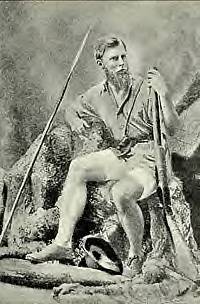 .. ..
Portrait of Frederick Courteney Selous
with his 4 bore single-shot smoothbore
"gun" and African hunting regalia, 1876. |
.
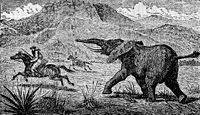 .. .. |
The first 4 bores were probably single barrel muzzleloaders
converted from British fowling pieces. Loads (bullet weights and gunpowder
loads) varied greatly. As the weight and strength increased, gunpowder
loads went from 8 drams (0.5 oz) to a full ounce (16 drams), or more, of
powder. The advent of rifling after about 1860 allowed longer conical projectiles
to be stabilized, and, aside from accuracy, these provided even greater
weight and penetration, with some hardened lead or steel bullets weighing
as much as 2000 grains. The 4 bore was also occasionally used for shooting
exploding projectiles. The transition from smoothbore to rifled barrels
did not occur overnight, since dangerous game was shot at ranges under
40 yards where a smoothbore was sufficiently accurate, provided higher
velocities, and needed less cleaning. The smoothbore also, at least until
the advent of breechloading, could be reloaded faster. |
Many famous elephant hunters during the 19th century used
such weapons, including George P. Sanderson in India and William Finaughty
and Frederick Courteney Selous in Southern Africa. Sanderson, in particular,
mentioned two each four bore firearms that he used, one of which was rifled
whilst the other was not. Although both weapons were of similar weights,
the rifle was built to accommodate only one barrel with a powder charge
only five-sixths that of the smoothbore, which was a double-barrel. Sanderson,
in fact, discarded the rifle after a misfire of the weapon's cartridge
almost led to his death, and the instance demonstrated the superiority
of the smoothbore over the rifle in the case of an oversized firearm in
his day in his mind. However, once again, as rifling and steels improved,
the smoothbore was doomed to die and be replaced completely by rifled breechloading
4 bores in the 1880s. With the advent of breechloading cases in the
late 19th century the 4 bore came into its current guise, that being the
well-known 4-4.5" brass case.
Smoothbores became a lesser choice, as did muzzleloaders.
The cartridge brass case was around 4 inches (100 mm)
long, and contained three types of loads: light at 12 drams, 14 drams at
regular, and 16 drams of powder at heavy load. (Note: 1 dram = 27.34375
grains in the avoirdupois system, since 256 drams = 7000 grains = 1 pound
of powder. Shotgun shells are still rated in terms of the same archaic
dram measurements, relative to their equivalence of smokeless powder load
to a blackpowder load weighed in drams.) John "Pondoro" Taylor mentioned
in his book African Rifles and Cartridges that the 12 drams (328 gr., 3/4
oz.) charge would propel the projectile at around 1330 fps. A double barreled
rifle that would fire such a calibre would weight around 22-24 lbs bare,
while the single-barreled version would be around 17-18 lbs. In common
practice, the cartridge cases were not typically reloaded, as reliability
was of the utmost importance, more important than a possible false cost
savings from an attempt at reloading that might cost a hunter his life.
Bullet lubrication was typically mostly beeswax based, such that in hot
tropical climes there could be no possibility of a bullet lube melting
from the base of the bullet, ruining the charge of powder within the cartridge.
Reliability was the utmost concern.
Golden Age and later usage
This caliber was used heavily by the European hunters,
notably so British, in tropical climates of Africa and India. Meant to
be used with black powder due to its size, it was unpopular due to the
problem of thick smoke and a powerful recoil. Notable hunters that used
the rifles included Sir Samuel White Baker and Frederick Selous, who used
it consistently in his career as an ivory hunter of African elephants between
1874 and 1876 until the advent of the lighter, more accurate and less cumbersome
Nitro Express calibers and cordite propellant. In the mid 1870s, Selous
favoured a four bore black powder muzzleloader for killing elephant, a
13 lbs short barreled musket firing a quarter pound bullet with as much
as 20 drams (540 grains) of blackpowder. He could wield it even from horseback.
Between 1874 and 1876, he slew exactly seventy-eight elephants with that
gun, but eventually there was a double loading incident together with other
recoil problems from it, and he finally gave it up as too "upsetting my
nerve".
| Although a weapon of immense power, the four bore was
far less effective than its Nitro Express successors because of the low
penetration of its projectiles and its immense recoil. The huge lead slugs
fired by the gun were sometimes capable of stunning a charging African
elephant to stop it on its tracks, or turn its charge(causing it to change
direction to avoid the hunter)but it was generally unable to kill the creature
outright with a frontal brain shot.
Chest and broadside shots were effective killers, as was
the side shot on brain where the skull is thinner on elephant, however
once again this did not help for instantly stopping an enraged elephant
charging the hunter. On the other dangerous game species such as the Indian
elephant, buffalo species and Rhino it was considered an excellent killer.
The use of four bore elephant guns in fiction, such as in Allan Quatermain,
the sequel to King Solomon's Mines, was a common theme during the Golden
Age of African hunting and in Lost World type adventure stories published
in the late 19th Century and early 20th Century. The four bore also figures
prominently in more recent fiction, such as Unintended Consequences. |
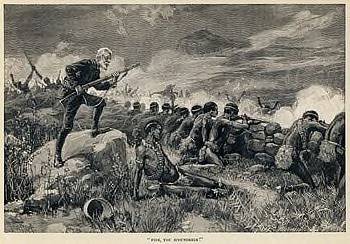
Allan Quatermain, having waited until the last minute
while
holding his elephant gun, orders his men to fire in this
illustration
by Thure de Thulstrup from Maiwa's Revenge (1888). |
|
| 2 bore from Wikipedia (thought
this went nicely with the 4 bore. I especially like the comments at the
end)
The two bore or 2 bore is a mostly
obsolete firearm caliber.
Specifications
The two bore fired spherical balls
or slugs of hardened lead or, in more modern cartridges, a solid bronze
projectile. The gauge was 1.32 inches (34 mm), and the projectiles generally
weighed about 8 ounces (225 grams; 3500 grains). The velocity was relatively
low, at its best around 1,500 feet per second (460 m/s) at the muzzle,
but hit with approximately 17,500 ft·lbf (23,700 J) of energy.
History and background
The largest size ever created for
a shoulder rifle, and used mainly in the 19th century for hunting large
and potentially dangerous game animals, this caliber was used by the European
hunters, notably the British, in tropical climates of Africa and India.
Meant to be used with black powder due to its size, it was unpopular due
to the problem of thick smoke and a powerful recoil. The rifle was meant
to be fired from the shoulder by one person; larger guns existed, such
as the punt gun, but these were only fired supported and generally from
a prone position. Sir Samuel White Baker, a notable British explorer and
hunter of the Victorian era, was impressed by its power, but heavily disapproved
of the recoil. He narrates dashing adventures with his two-bore rifle,
which he affectionately referred to as "Baby" :
| “Among other weapons, I had an
extraordinary rifle that carried a half-pound percussion shell; this instrument
of torture to the hunter was not sufficiently heavy for the weight of the
projectile: it only weighted twenty pounds, thus with a charge of ten drachms
[270 grains] of powder and a HALF-POUND shell, the recoil was so terrific,
that I spun around like a weathercock in a hurricane. I really dreaded
my own rifle, although I have been accustomed to heavy charges of powder
and severe recoils for some years. None of my men could fire it, and it
was looked upon as a species of awe, and it was name "Jenna-El-Mootfah"
(Child of a Cannon) by the Arabs, which being a far too long of a name
for practice, I christened it the "Baby", and the scream of this "Baby"
loaded with a half-pound shell was always fatal. It was too severe, and
I seldom fired it, but it is a curious fact that I never shot a fire with
that rifle without bagging. The entire practice, during several years,
was confined to about twenty shots. I was afraid to use it, but now and
then as it was absolutely necessary, it was cleaned after months of staying
loaded. On such occasions my men had the gratification of firing it, and
the explosion was always accompanied by two men falling on their backs
(one having propped up the shooter) and the "Baby" flying some yards behind
them. This rifle was made by Holland & Holland, of Bond Street, and
I could highly recommend it for the Goliath of Gath, but not for the men
of A.D. 1866." |
|
All articles submitted to the "Brimstone
Gazette" are the property of the author, used with their expressed permission.
The Brimstone Pistoleros are not
responsible for any accidents which may occur from use of loading
data, firearms information, or recommendations published on the Brimstone
Pistoleros web site. |
|